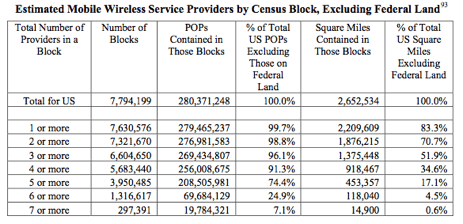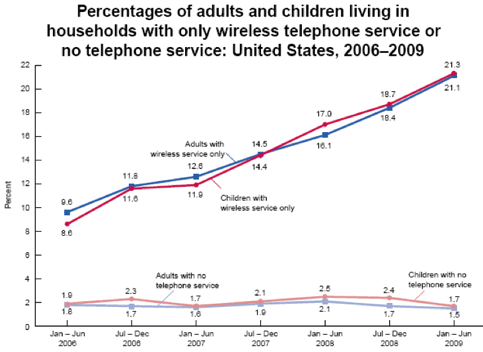FCC's 14th Wireless Competition Report

FCC today released the 14th annual Wireless Competition Report required by Congress. (Previous reports are here.) The report differs somewhat from its predecessors:
In this Mobile Wireless Competition Report to Congress (Fourteenth Report or Report), we incorporate several important new forms of analysis that reflect fundamental shifts in the mobile marketplace. For example, whereas previous reports analyzed Commercial Mobile Radio Service (CMRS) competition and discussed a variety of metrics – including number of providers, subscribers, usage, and prices – this Report integrates an analysis of CMRS into an analysis of all mobile wireless services, such as voice, messaging, and broadband. This Report also goes beyond previous reports in reflecting the transformative importance of mobile wireless broadband, which has resulted in a shift from devices that can place traditional phone calls to pocketable devices that can access the entire Internet. Because each of the interrelated segments of the mobile wireless ecosystem has the potential to affect competition, this Report analyzes competition across the entire mobile wireless ecosystem, including, for the first time, in-depth analyses of “upstream” and “downstream” market segments, such as infrastructure and devices.
Weighing in at 237 pages (!) it has a wealth of information on the state of the wireless industry. Here are the key conclusions:
• Maturation of the Mobile Voice Segment. As of the end of 2008, 90 percent of Americans had a mobile wireless device, and Americans used these devices to talk for an average of 709 minutes each month. While usage statistics have generally increased over time, this year marks the first instance of reduced (though still substantial) voice usage, perhaps due to increased reliance on text and multimedia messaging. Voice revenues stayed relatively steady compared to past periods, with average revenue per user (ARPU) slightly decreasing but revenue per minute (RPM) slightly increasing.
• Transition to a Data-Centric Market. Data traffic has grown significantly, due to the increased adoption of smartphones and data consumption per device. Indeed, with overall revenue permobile customer generally remaining flat the past several years, revenue from newer data services is replacing revenue from traditional services.
• Proliferation of Devices and Applications. Handset manufacturers have introduced a growing number of smartphones that provide mobile Internet access and other data services, and use operating systems that provide many of the functionalities of personal computers. The four nationwide providers launched about 67 new smartphones in 2008 and 2009, based upon several different platforms (e.g., Apple iPhone, Android, BlackBerry, Palm, and Windows Mobile). The Android and iPhone platforms have been particularly successful in creating an entire ecosystem of applications and services. As of December 2009, there were over 100,000 applications on the Apple App Store, and 15,000 on the Android Market.
• Continued Industry Concentration. Over the past five years, concentration has increased in the provision of mobile wireless services. The two largest providers, AT&T, Inc. (AT&T) and Verizon Wireless, have 60 percent of both subscribers and revenue, and continue to gain share (accounting for 12.3 million net additions in 2008 and 14.1 million during 2009). The two next- largest providers, T-Mobile USA (T-Mobile) and Sprint Nextel Corp. (Sprint Nextel), had a combined 1.7 million net loss in subscribers during 2008 and gained 827,000 subscribers during 2009. One widely-used measure of industry concentration indicates that concentration has increased 32 percent since 2003 and 6.5 percent in the most recent year for which data is available.
• Robust Capital Investment but Declining Relative to Industry Size. Providers continue to invest significant capital in networks, despite the recent economic downturn. One source reports capital investment at around $25 billion in both 2005 and 2008, while another shows that capital investment declined from around $25 billion to around $20 billion during the same period and that investment during the first half of 2009 was $8.9 billion. Because industry revenue has continued to grow, both sources show that capital investment has declined as a percentage of industry revenue over the same period (from 20 percent to 14 percent).
• Role of Spectrum for Mobile Broadband. Especially as mobile wireless data usage grows, spectrum becomes an increasingly pivotal input. In particular, lower-frequency spectrum possesses superior propagation characteristics that create certain advantages in the provision of mobile wireless broadband service, especially in rural areas. Lower-frequency spectrum potentially allows for a higher quality of coverage with fewer cell sites, when compared to other frequency bands used to provide mobile services. Conversely, higher-frequency spectrum may be effective for increasing capacity, particularly within smaller, more densely-populated geographic areas. Recent auctions reflect that lower frequency bands are more highly valued than higher frequencies. A significant portion of spectrum below 1 GHz is held by the two largest providers: 67 percent of the 700 MHz band, and 91 percent of the Cellular band, based on megahertz-POPs (MHz-POPs).
I was fascinated by the following graph on p. 18 showing the crosselasticity between cellphones and traditional telephony:

One topic that is missing from the report but of growing importance is the asymmetry of traffic flows in commercial wireless services. The report carefully documents the growth of messaging, 1-way video, and Internet use, but makes no statements about the resulting traffic asymmetries. Indeed a search on the word shows that asymmetry is never mentioned in the context of traffic flow. Yet it is a key issue in how to plan future spectrum for such services.
Hopefully the next report will address such issues.



![Validate my RSS feed [Valid RSS]](valid-rss-rogers.png)

